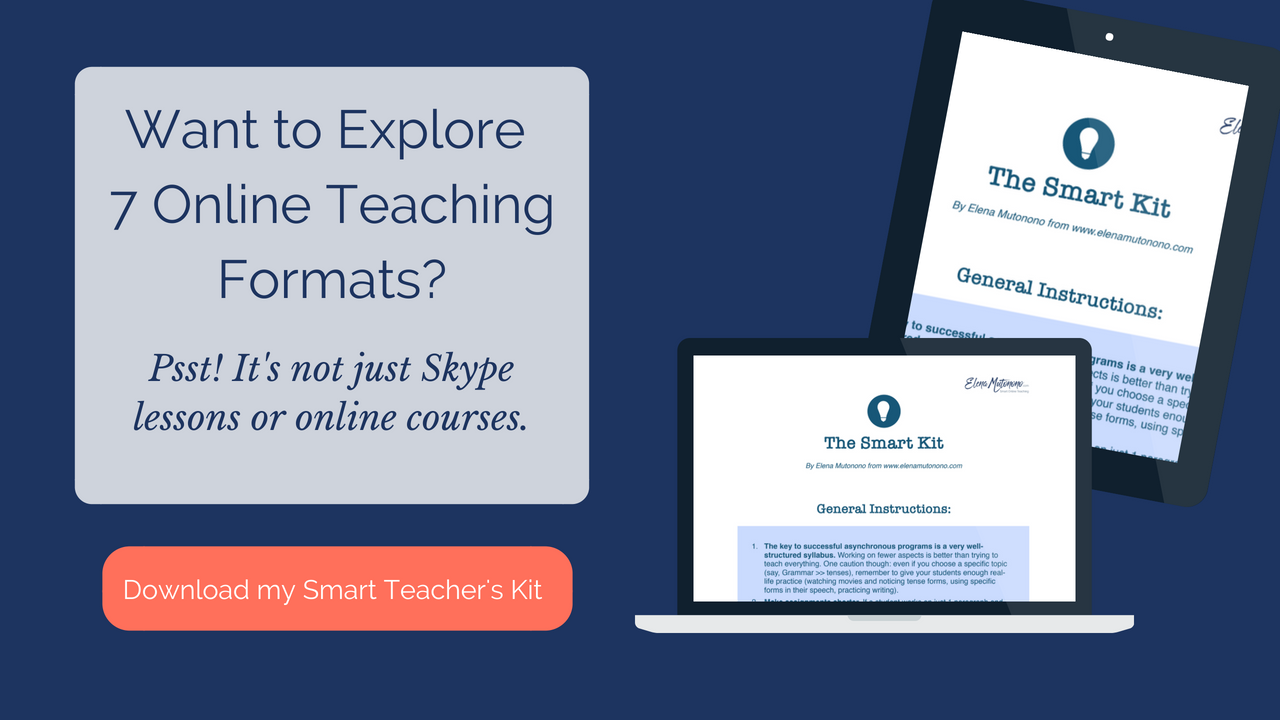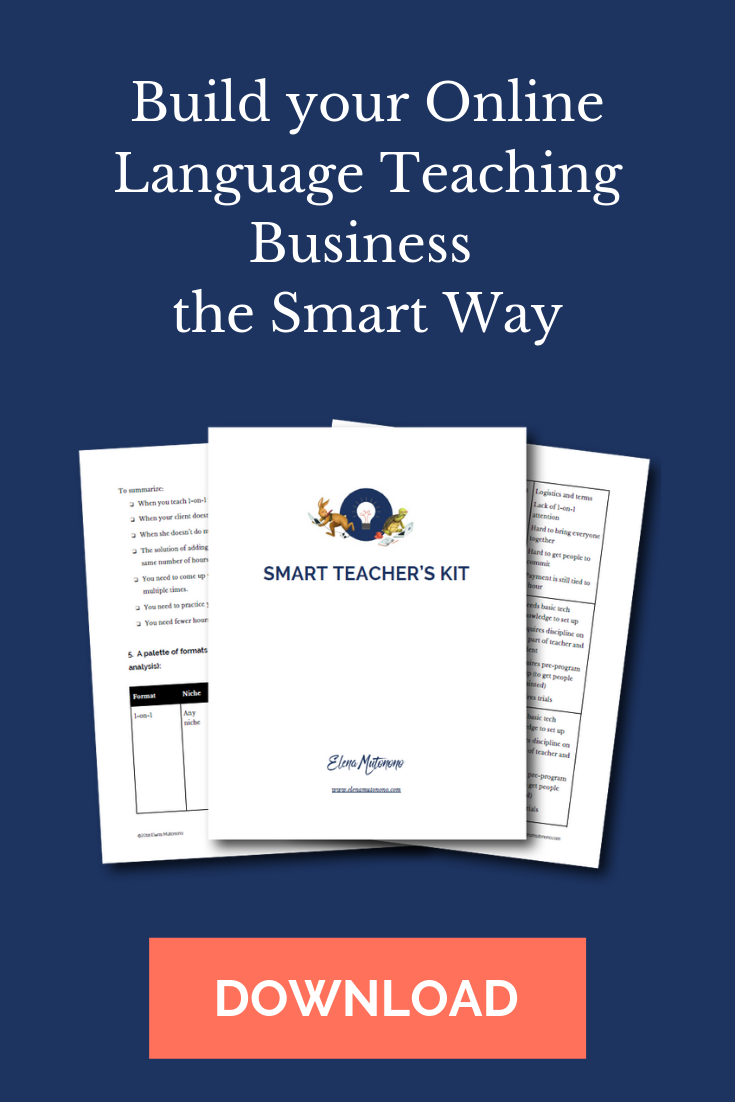At some point of your online teaching journey you will begin building momentum. In this post I want to set up your expectations right so you know what your priorities are if you want to teach smart.
In the previous post I talked about the first two stages of working online. These are the first steps in your life of a teacherpreneur, and when you’re just beginning it’s fun and exciting.
You want to do everything, experience everything, you’re enthusiastic and full of energy. You’re ready to conquer the world! This is great! You’re learning a lot, adding a whole gamut of skills to your resume and getting more work as you go along.
As I mentioned, the greatest danger in the first two stages of your business is when you keep piling work on yourself until you can no longer breathe. At some point though you will realize that in order to deliver quality you must make some adjustments.
I’ve suggested a number of them: raising the price, offering different kinds of packages (with fewer lessons perhaps), developing partnerships with other teachers, creating some authentic materials.
However, if you keep growing (which is fantastic) you’ll be constantly feeling the pressure of needing to reorganize your work once again. It is normal. Never be satisfied with your status-quo. Always look at what’s ahead of you.
Stage 3 of Online Teaching
When you get to your 3rd stage of teaching a language/languages on your online platform you already have some systems in place that help you stay focused on running your business, not just teaching.
Although many of us would just love to chuck everything and spend the entire day talking to students, we now need to become more selective when choosing our students.
For instance, at this point you can only take those that are able to pay more, that have higher goals, shorter deadlines, and more specific training needs. Teaching English 101 is quite interesting, but after some time it can get old unless this is what you decide to concentrate on.
To grow professionally you need to narrow down your area of expertise and teach/train fewer, not more students to provide more outstanding quality. This is what you will be more inclined to do once you move into the third stage of your online business development.
3rd stage checklist:
#1. Recruit private students and teach some.
A lot of people think that the more students they personally teach the better school they have (I’m not talking about the model where you delegate your students to other teachers – there you can have as many as you want, I’m talking about you personally).
But the opposite is actually true. Your personal language learning platform becomes more efficient if you, as the owner, move away from the day-to-day teaching and focus more on teacher training, personnel development, marketing and social networking.
Continue training your teachers and developing relationships with your fans. You may design partnerships with a select few of your students where you ask them to help you spread the word. Give them a special discount or a couple of free lesson as a reward for each prospect that comes through them and becomes your student.
Find a way where you can help each other out: provide some editorial services in exchange for students (be sure to think through the partnership before you offer it and draft the conditions on paper).
#2. “Pass your students on” more frequently (create partnerships/affiliate relationships).
This has to become a habit. Once you have accomplished your goals with the students, find ways where you can either switch them to a “retainer” course (autonomous, lower fee, fixed rate, meet once a month) or to move them to another teacher to work on other skills (like writing can be very well taught by an experienced ESL teacher who is a native speaker).
#3. Focus on marketing, blogging, referrals, deals.
Set a goal to do one promotional thing a day: you can share a post on social media, write a summary of an existing post on LinkedIn or Medium, or something else that will bring in the flow of clients. Don’t lose your momentum.
#4: Create your own content: free and paid.
A year into my skype teaching, I developed 3 online Grammar courses and began selling them. Then I turned one course into an e-textbook, and students would buy it before they started taking lessons.
It made my work much easier because it decreased the number of hours I had to spend coming up with some materials over and over again, and it allowed me to “upsell” – provide a product that went together with an initial lessons package and boosted my income.
What to do when your #online #business starts growing. Set up priorities to allow #growth.Click To Tweet
#5: Develop packages (with limited teacher’s presence online).
As you go through the year (and years) of running an online platform you will notice that there will be high peak seasons and low seasons. I’d say that low seasons for me are December/January, summers (although it depends on a year, recently I’ve been pretty busy), and May (most Russian and Ukrainian students I’ve trained take up to 2 weeks off on May – crazy, I know).
For months like those, instead of losing money you can create fixed-rate packages that require minimum homework, lots of fun, and no live lessons. I created one a few years ago and called it “The English Lab”, and it was quite successful for a pilot project.
I used wiggio.com (no longer available – ed.) to create a closed group, but you can use social media as well. I created a customized program with 4-5 assignments for the upcoming month where students had to post their podcasts, videos, and written reflections.
With time you may need to change the name of this package or “recreate it” to be a Movie Club or a Boot Camp of some sort, but in essence it’s the same concept: make money when the students are not inclined to take private lessons.
#6: Write and sell materials.
By now you will have probably collected a lot of materials that you could sell. Those worksheets on specific subjects? Your own videos with quizzes? Some podcasts? Put them all together and sell them!
Don’t wait until they are perfect, start selling them now. The students will help you improve them, but you will still be making money instead of thinking how to find some extra revenue.
#7: Outsource website development and part of the accounting.
Up until now you’ve been running your own blog/website, and it worked great for you. But as you move into the next stage where you get fewer clients, higher rates and tailor packages to suit specific needs, you may need to make some changes to your website.
So outsource this, but don’t try to revolutionize everything. Start small: update your most important pages to look more appealing – about me, packages, contact me. Do a few projects at a time so you can afford to pay the developer and not overwhelm yourself with giving instructions.
Check out this FREE Copy Detox challenge by Veronika Palovska to help you improve your website copy so it works better for you.
Grow as an #online #teacherpreneur. Here's what to expect when your business gains momentum.Click To Tweet
Stage 4: Checklist
As you’re getting closer to the 4th stage, you will see the tendency to minimize your teaching work load to produce more quality. It’s better to have 3-5 clients that you give absolutely phenomenal attention to and pass the rest of them to your colleagues that by now will have shown their specific talents as well.
You will now focus more on increasing your passive income revenue (though it doesn’t really mean “passive”, just means more flexible) like writing books, textbooks, publishing courses and marketing them.
So, here’s your final stage in the 4-tier pyramid:
- Recruit private students for others and teach very few, only the select ones.
- Implement different teaching strategies for yourself (retainer courses, automated “free trial” services, low-cost/time-saving, more autonomous learning).
- Train the teachers that work with you. Or refer students to other teachers. I read somewhere recently, “What is worse than training your staff and watching them leave? Not training and working with them.”
- Focus on marketing, blogging, referrals, deals, daily!
- Develop a new course (or 2) and promote it. Use WizIQ, Udemy, or Teachable to host your courses.
- Write a book and promote it. Once you have completed a course, why not write a book to go with it?
- Keep creating your own content (Free and paid).
- Outsource and delegate. By the time you reach this level there might be other things you might need to outsource.
An acquaintance of mine is running an online platform that has become quite successful in the last 2 years (he’s had a few years building up to it though).
He used a bit different model than the 4 stages presented, but he worked on one project at time, too, and hence was able to get to a point of freedom! When I asked him about his secret he used one powerful word consistency. He said,
“A lot of people get bogged down too early and stop writing, recruiting, marketing, and producing content. This is where your consistency and focus on the goal will pay off.”
Another, similar quote, is by Jack Askew the owner of Teaching ESL Online,
Momentum is vital. The first stages are like pushing a rock up a hill. It takes hustle to get things moving. That’s why consistency is key.
I hope I’ve encouraged you to go beyond what you can see and stay consistent as you work on one project at a time to build your smart online teaching business.




 Welcome to my nook where *Big Magic* happens. My name is Elena Mutonono, I help small business owners package their services as digital products and sell them online. I want you to work smarter, not harder. Increase your impact beyond your current face-to-face clients. Grow your business as you reach more people all over the world.
Welcome to my nook where *Big Magic* happens. My name is Elena Mutonono, I help small business owners package their services as digital products and sell them online. I want you to work smarter, not harder. Increase your impact beyond your current face-to-face clients. Grow your business as you reach more people all over the world.








An inspiring and informative piece of writing!
Thank you! I’m so glad. Stay tuned.
Hello Elena,
Great article!
I am curious about Wiggio. Are there any other programs like it?
Thanks you!
Hey. A good person to inquire about anything new developing in the area of online learning technologies would be Nik Peachey (http://nikpeachey.blogspot.com/). He was the one who initially pointed me to wiggio. He listed a few other resources, but they didn’t work for me. For full-blown online classes I use udemy.com (I actually have a course on there, too), but for small project groups I think wiggio does its job best, and it’s free, too)